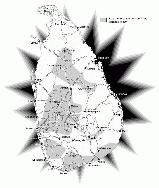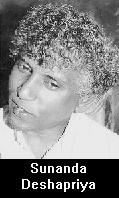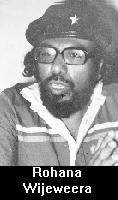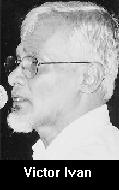Revolution in retrospect
News/Comment|
Plus| Business| Sports|
Mirror Magazine

 It
was April 6, 1971. They waited in suspense. The groups scattered across
the country. In 'camps', around tiny transistor radios, in twos and threes.
They were awaiting the word from their leader that the "kotang anduwa"
had won the day.
It
was April 6, 1971. They waited in suspense. The groups scattered across
the country. In 'camps', around tiny transistor radios, in twos and threes.
They were awaiting the word from their leader that the "kotang anduwa"
had won the day.
But what came over the waves was the usual morning pirith, shattering the hopes of thousands and thousands of youth.
The "one-day" revolution had failed. With it, the hopes of more than 10,000 youth to establish a form of government that vindicated their grievances and set up a social system, which was fair to all.
"We were home-made revolutionaries, with no proper arms and ammunition and bombs made of tinkiri tins," says 'Asoka'. The Badulla District Secretary, who was in a safe house in Bandarawela that day heard the pirith instead of Rohana Wijeweera's victory speech (in fact recorded by a member who sounded like Wijeweera) and knew the "Aprel kerella" (the April insurrection) had failed.
He and some 100 others who had gathered to attack the Haputale Police Station, retreated through Attampitiya to Uda Pussellawa and on to the Walapone jungles, heading for Hunnasgiriya. On the way, they collected guns from people who possessed licensed firearms.
Information, meanwhile, was trickling in that the "kotang anduwa" (the name coming from the fact that the youth were cutting trees, removing lamp posts and telephone posts and using them to barricade roads and hinder the movement of the army and the police ) had triumphed in Batapola, Ambalangoda and some areas of Anuradhapura. Asoka, 21, and his band of young revolutionaries were hoping to join forces with them. But when they reached the Hunnasgiriya Road, the arduous journey had taken its toll. After a dispute, the group split up, some deciding to head for the safety of the Knuckles mountain range. 'Asoka', though, went on undeterred, for the ideology of the Movement was firmly embedded in him.
For Sunanda Deshapriya alias 'Asoka' had met the Movement's charismatic leader Rohana Wijeweera as a young boy of 16 in 1967. Wijeweera was a frequent visitor to his home in Ambalangoda, as a Communist Party (CP) activist working alongside his father. Many were the discussions on politics, they had into the night, with Wijeweera gradually focusing his attention on the teenager. Wijeweera's influence was so overpowering that the young student of Dharmasoka College, Ambalangoda, even chopped off his "fashionably" curly hair and stopped going for movies. Wijeweera's instructions were firm. There should be no diversions, no distracting relationships.
"In hindsight, it seemed like a political cult," says Sunanda.
Wijeweera targeted O'L and A'L students and unemployed graduates. Garnering new members into the fold was referred to as "koku gahanava", recalls Sunanda.
Who then was the man behind the cult, the man who inspired 10,000 youth to take up arms for a cause, for which they were ready to sacrifice their lives?
Born at Tangalle on July 14, 1943, Patabendi Don Nandasiri Wijeweera was the eldest son of Don Andiris Wijeweera and Nasi Nona Wickrama Kulutota. The family lived at Kottegoda where his father had a small business. The young Wijeweera went to Godauda government primary school and then the Godauda senior school before entering Dharmasoka College, Ambalangoda to sit for the O'Ls. Though he passed quite creditably, he could not continue his studies because of the tragedy that befell his father.
The elder Wijeweera was a CP member and while working on an election campaign in 1947, had been badly assaulted. He was subsequently bed-ridden and so the son found himself unable to continue his studies. Deeply influenced by his father's affiliations, the young Wijeweera too supported the CP, working actively in the 1960 election campaign. He saw Dr. S.A Wickremas-inghe as his mentor and as a youngster read avidly, imbibing the literature of the worldwide Communist movement. With the help of the victorious CP candidate for Kamburupitiya, Aelian Nanayakkara, Wijeweera applied for and won a scholarship to study medicine at Moscow's Patrice Lumumba University, the youngest at 17, to gain entrance there.
The Moscow experience deepened his convictions and his knowledge of the Marxist/Leninist philosophies. He completed three years of study successfully, before illness forced him to return to Sri Lanka for recuperation.
By then, Wijeweera's heart was more set on politics and his leanings were towards the Peking Wing of the CP. His criticism of Soviet policies came to the notice of the authorities and he was denied a visa to return to Moscow to continue his medical studies.
Now actively supporting the Peking Wing of the CP, Wijeweera during this period met the men who would become his brothers in the JVP's inner circle. Wijesena Vitharana alias Sanath, a teacher from Kalattawa, 'Karu', W.T. Karunaratne from the Inland Revenue Department, Nimalsiri Jayasinghe alias 'Loku Athula' and Piyatileke Samararatne, known as 'Machang', were all disillusioned members of the Peking Wing.
During Vesak 1965, following the SLFP/ LSSP/CP defeat at the hands of the UNP, Wijeweera invited a select group from the Peking Wing to Karunaratne's house in Akmeemana, Galle to discuss their future within the CP. The discussion went on for two days and it was perhaps here that the seeds of their revolt were sown.
Meanwhile, within the Peking Wing, Wijeweera was given the task of re-organising the youth, but he used this opportunity to promote his own Marxist, Leninist thinking to them. Matters came to a head when the leadership got wind of his activities; he was expelled from the Party in 1966.
Wijeweera's campaign for a secret revolution began in earnest in late 1967. Wijeweera, Sanath, Karunaratne, Piyatileke and Loku Athula met at Kalattawa and decided to introduce people to their interpretation of Marxism, through a series of classes. Inspired by the revolutionary ideals of Che Guevara, Fidel Castro's Cuban comrade, they believed that a small group could bring about a revolution.
In his book 'The JVP 1969-1989', Justice A.C. Alles, who served on the Criminal Justice Commission which inquired into the insurrection, writes, "Wijeweera and the original members of the Movement believed that no political party in this country was truly Marxist-Leninist.............That power could not be captured from the capitalist rulers by the democratic method of holding elections."
 The
indoctrination took the form of five classes. The first dealt with the
'economic crisis', the problems facing the peasant farmer and the rural
worker. The second was on 'Independence' giving a historical background
into the ill-effects of colonial rule. The third on 'Indian expansionism'
focused on how Indian capitalists were trying to spread their tentacles
into smaller countries. The fourth was on the Left movement, purportedly
drawing lessons from the failure of the Old Left to make any serious impact
on local politics. The fifth class, which came later, was on 'the path
the Revolution should take'.
The
indoctrination took the form of five classes. The first dealt with the
'economic crisis', the problems facing the peasant farmer and the rural
worker. The second was on 'Independence' giving a historical background
into the ill-effects of colonial rule. The third on 'Indian expansionism'
focused on how Indian capitalists were trying to spread their tentacles
into smaller countries. The fourth was on the Left movement, purportedly
drawing lessons from the failure of the Old Left to make any serious impact
on local politics. The fifth class, which came later, was on 'the path
the Revolution should take'.
"Wijeweera, whom the rank and file knew only as Mahaththaya, spoke a lot about cultural imperialism and advised us, students, against aping the west. We were asked to stop going for films and parties. This was done to stop what he saw as cultural degeneration. No diversions, no romantic relationships were tolerated. He wanted us to be completely devoted to the Marxist ideals. We were also supposed to identify with the poor, move away from our comfortable middle class backgrounds and start thinking about the underprivileged," says Sunanda.
Within the Movement, it was the practice to use aliases to prevent identification of the members, perhaps in fear of betrayals.
Sunanda's home by then was the venue of classes after school. His younger sister too was a full-timer in the Movement. Sunanda along with other schoolboys who were fully involved now, went around the country to gather more support and spread the word.
"Classes were held in the night, in cemeteries for small groups of five or 10.
We had a sense of adventure and never felt the hardship. We would travel without any money for bus fare and walk into a boutique, eat and walk out without paying. "Polu thibba," says Sunanda.
 In
1969, Sunanda "graduated" to a camp. The five-day session was held in an
old house on a hill in Akmeemana and here Wijeweera was at his charismatic
best, delivering an eight-hour lecture. "The camps were held in protected
places. The trainees had to be up by 4 a.m. for military-style drills and
arms training by navy personnel who had been drafted in from the CP." A
rudimentary form of military training was given at the camps, with sketches
of guns on the blackboard, pictures of rifles being circulated and rifle
drills and karate being taught. These camps were held in places like Kurunegala,
Akmeemana, Tissamaharama, Elpitiya and Anuradhapura.
In
1969, Sunanda "graduated" to a camp. The five-day session was held in an
old house on a hill in Akmeemana and here Wijeweera was at his charismatic
best, delivering an eight-hour lecture. "The camps were held in protected
places. The trainees had to be up by 4 a.m. for military-style drills and
arms training by navy personnel who had been drafted in from the CP." A
rudimentary form of military training was given at the camps, with sketches
of guns on the blackboard, pictures of rifles being circulated and rifle
drills and karate being taught. These camps were held in places like Kurunegala,
Akmeemana, Tissamaharama, Elpitiya and Anuradhapura.
Generally between 30 to 100 would attend these camps. It was roughing out time. The members had to live off the land getting vegetables and other produce from nearby chena cultivators. "Every year, the Movement collected rice and money for a big dansala in Anuradhapura. Some of this rice was kept for the camps."
By May 1970, the Movement had a name — the Janatha Vimukthi Peramuna.
Justice Alles describes the fledgling Movement's organisational structure thus: "There were groups of five with a leader. There would be several such groups in a police station area. These groups appointed one of the leaders as an area leader. The leaders of the areas selected a district leader who would be in charge of the entire district. The district leaders were members of the Central Committee above which was the Politbureau, which in the case of the JVP consisted of 12 persons, including some of the district secretaries and the four top leaders."
The government, meanwhile, was not totally unaware of the JVP's activities. A special CID unit was set up to probe the 'Che Guevara' clique, whom Opposition Leader Sirimavo Bandaranaike had made a reference to in her May Day speech in 1970. On May 12, 1970 Wijeweera was arrested at Julgamuwa, in the Hambantota district. He was freed in July after JVP cadres organised a major agitational campaign for his release. He then began in earnest, the move to arm the JVP as around the country, activists were being arrested or assaulted by the police.
By this time the JVP was a force to be reckoned with. On its A List were 10,000 full-time members, including some 200 women and a handful of Muslims. There was also a B List of sympathisers and a C List of those who could be approached for help.
Kegalle and Galle were the hotbeds with over a thousand full-timers each, Badulla (where Sunanda was the District Secretary) had around 500 members. Despite the lack of weaponry, the full-timers were equipped with blue uniforms, military boots, haversacks and were supposed to have a shotgun each.
Communication was by code. The Politburo met every two months in Colombo and the District Secretaries would take back the message to the districts. The JVP was organised on the lines of police divisions and police committees and this was the era when telephones were not freely available. From the District Secretaries, couriers or "mallis" who knew the hideouts would take the messages to the cadres.
 As
part of the militarisation of the Movement, every member was asked to have
a gun and 10 cartridges ready. "Bombs were also being made using cheena
chatti, cast iron shells, dynamite and an elementary mechanism to blow
them up. Empty tinkiri tins were ordered from factories and sent around
the country to make crude bombs," says Sunanda.
As
part of the militarisation of the Movement, every member was asked to have
a gun and 10 cartridges ready. "Bombs were also being made using cheena
chatti, cast iron shells, dynamite and an elementary mechanism to blow
them up. Empty tinkiri tins were ordered from factories and sent around
the country to make crude bombs," says Sunanda.
The bombs may have been crude, but though technically raw, the youth who experimented with them were made of sterner stuff. On December 17, 1970, at Gonapinuwela, in Galle on a full-moon night, a grenade exploded while being tested. Victor Ivan alias 'Podi Athula' lying in a pool of blood begged his comrades to shoot him. His only thought was to prevent police from uncovering the JVP military wing's activities.
But the others, including the leader of the military wing, 'Loku Athula' would not desert him. Then Victor came up with the plan that they should put him into hospital, saying they had found him wounded on the road. He would, in turn, claim that someone had thrown something at him and fled. He was taken to Galle Hospital. Later a relative from the United Kingdom who was then working at Sulaiman Hospital, got him transferred there and performed a series of operations that saved his life. But the accident cost him his left hand.
Also from the deep south, Victor had studied at St. Aloysius College, Galle, run by the Jesuit priests where his support of the 1964 takeover of Catholic schools by the government had gained him a reputation as a troublemaker. He joined the Movement in 1967 and travelled across the country, holding classes and later organising trade union activity in Negombo and Puttalam. By 1970 he was involved with the military wing.
The Movement was now gathering momentum. Between July 1970 and the end of the year, Wijeweera addressed some twenty public rallies in places like Kegalle, Wellawaya, Tangalle, Negombo, Moratuwa and Elpitiya. The JVP also published its own paper, the Janatha Vimukthi, which was widely read. Several heists were also carried out by JVP members, among them the Okkampitiya bank robbery, the Badulla mail bag robbery, the Ambalangoda bank robbery and the York Street robbery to raise funds.
By early 1971, recruitment to the JVP had been stopped and members were urged to collect as much money as possible, through whatever means (mortgaging lands and homes) to arm the movement. The promise was that once the JVP secured power, the members would be able to reap the fruits of their sacrifice.
The first rumblings within the JVP, however, also came in early 1971, when some of the leaders were found to be having relationships with the daughters or sisters of other members. "Allegations of abortions being performed on these women spread and the Politburo reacted angrily. A decision was taken to keep these liaisons secret," says Sunanda. This was also the first inkling the JVP hierarchy had of their leader's weaknesses. On that day they called him 'Sahodaraya' (Comrade) instead of 'Mahaththaya'.
Then in February 1971, a clear warning went to the authorities that something was brewing among the university students. The JVP had hidden a large number of detonators in the ceiling of Peradeniya University's Marrs Hall and due to the heat, they began exploding like firecrackers. The explosions went on for five days. Meanwhile, in March a bomb explosion in Kegalle killed five JVP members. Activated, the police began raiding JVP hideouts. Within the Movement, pressure was building up to launch the revolution.
At the JVP's last public rally before the uprising, held at Colombo's Hyde Park on February 27, 1971, Wijeweera made a stirring call. "Let the revolution of the workers, farmers and soldiers be triumphant." Thereafter, in March he travelled around the country, visiting Hambantota, Colombo, Kandy, Matale, Dambulla, Polonnaruwa and Batticaloa. But on the 13th while in Ampara, he was arrested for a second time by a special Police team and later removed to the Jaffna jail. On March 16, the government declared a state of Emergency.
On April 2, a crucial meeting was held at 2 p.m. Nine members of the JVP inner circle met in secret at the Sangaramaya temple of the Vidyodaya University in Kelaniya. It was a meeting that would change the course of Sri Lanka's destiny. The inner circle decided that all police stations in the country would be attacked on the night of April 5. The meeting was apparently convened in response to a message sent from Jaffna jail by Wijeweera, who requested that posters and leaflets should be published calling for his release and in the case of an attack, 500 comrades should be sent to Jaffna to secure his release.
The die was cast.
Part 2 next week-Crushing the revolt







![]()
Front Page| News/Comment| Editorial/Opinion| Plus| Business| Sports| Mirror Magazine
Please send your comments and suggestions on this web site to


